Aruba, December 2015
In late December 2015 Roxanne, Ryan, and I took a trip to Aruba.
It is a small island located in the southern Caribbean and is only
about 15 miles off the coast of Venezuela. Considering the latitude,
it is somewhat surprising that it is not a tropical jungle.
Instead, Aruba averages less than 20 inches of rain a year and
is classified as semi-arid.
The trade winds blow pretty continuously, making the warm
temperatures quite comfortable.
We spent our time relaxing, visiting
beaches, hiking around looking for lizards and snakes, and eating good dinners.
One thing that I was hoping to see was the Aruba Island Rattlesnake
(Crotalus unicolor). Although I tried, that small aspect of the
trip was not successful.
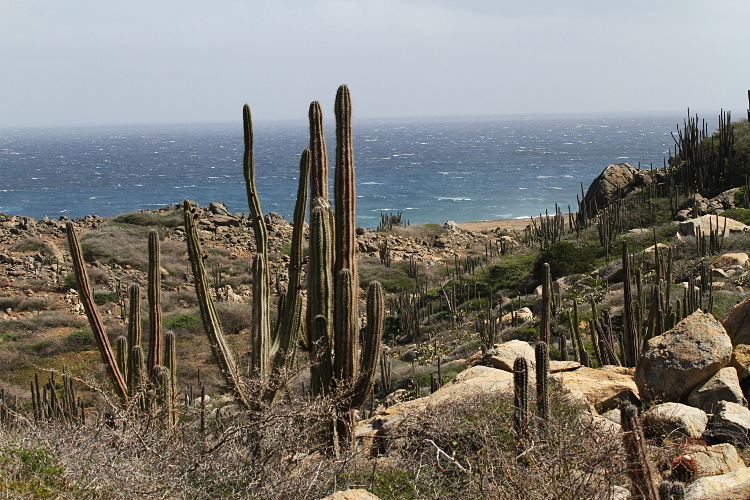
This is the typical landscape you see on the less-developed parts
of Aruba. This view was on the short hike to reach the beach from
the place we stayed at.
The island has many tall cacti that are very reminiscent of the
Saguaros that you seen in the Sonoran Desert of Arizona.
The vegetation in general reminded me very much of the thornscrub
that you see in extreme south Texas.
In many areas, the geology reminded me of what you find in southern
California, with rugged hills and lots of rounded granite boulders.
On the east side of the island there is coral limestone (barranca).
There is also some lava from volcanic activity.
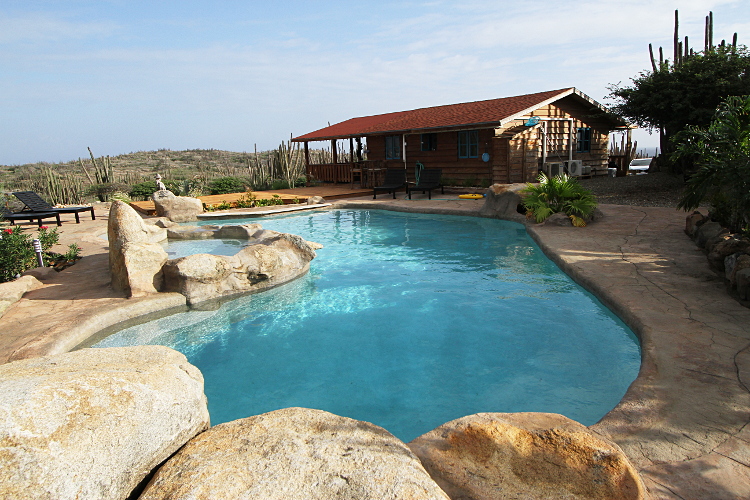
The small house we rented.
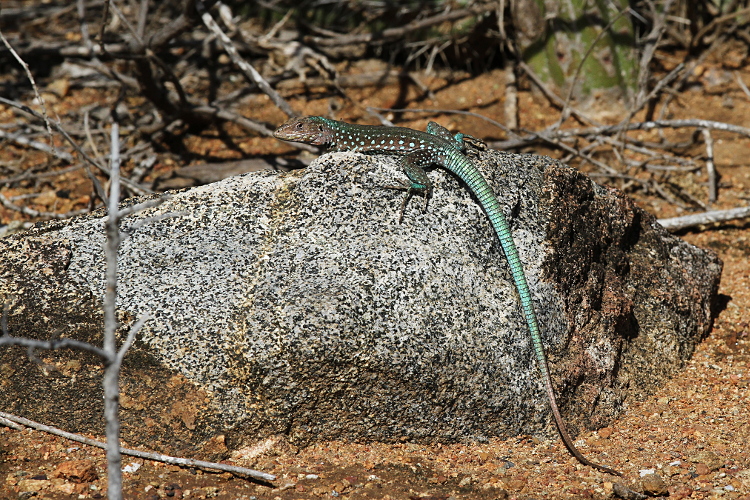
The Aruban Whiptail (Cnemidophorus arubensis), also known
locally as the Cododo. This species is
endemic to Aruba and proved to be remarkably abundant.
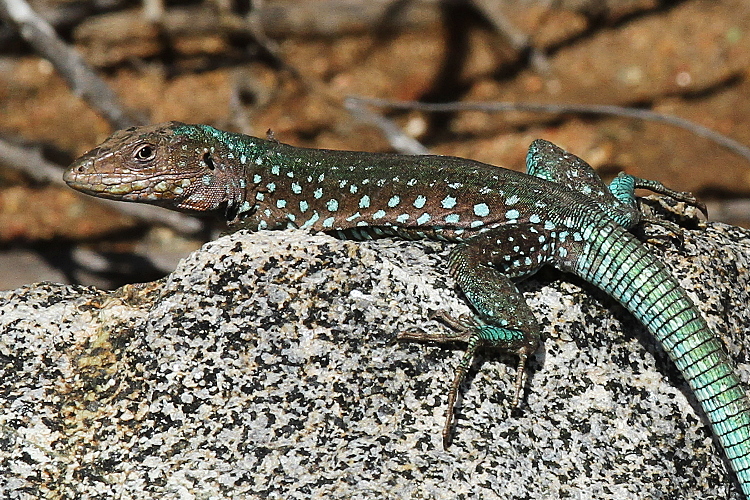
A closer look at the lizard. The males -- such as this one -- have
beautiful turquoise blue coloration.
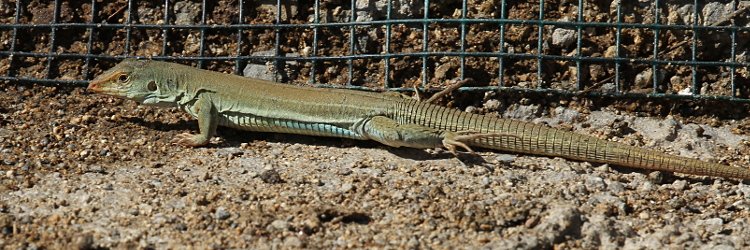
Cope's Ameiva (Ameiva bifrontata), another lizard from
the whiptail family. They are thought to be introduced, but they have
been on the island at least 150 years. They were less common than
the Cododos, and I did not get very good photos of them.
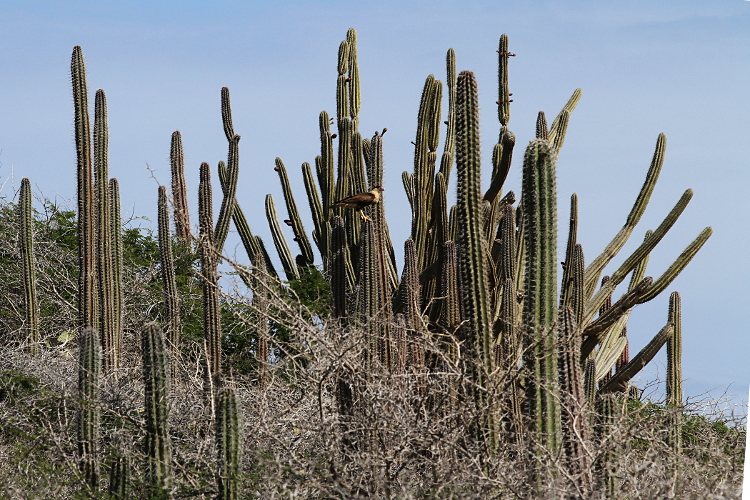
As we were walking to the beach on our first full day in Aruba,
we spotted this Crested Caracara (Caracara cheriway)
sitting on a cactus. They are a good-sized raptor in the falcon family.
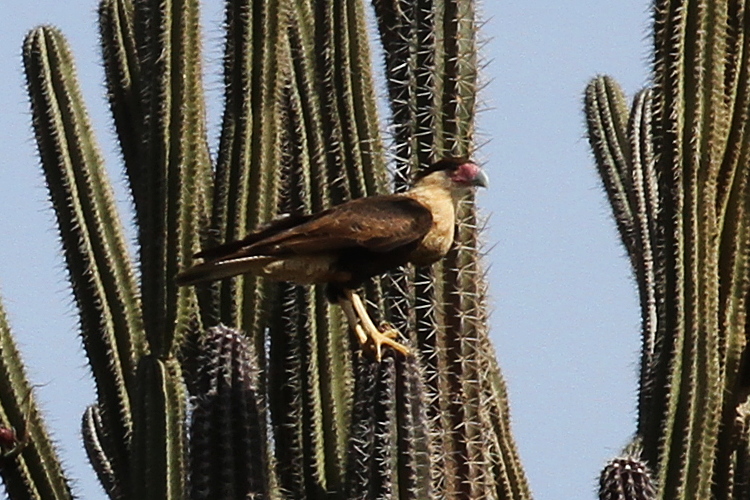
A closer look.
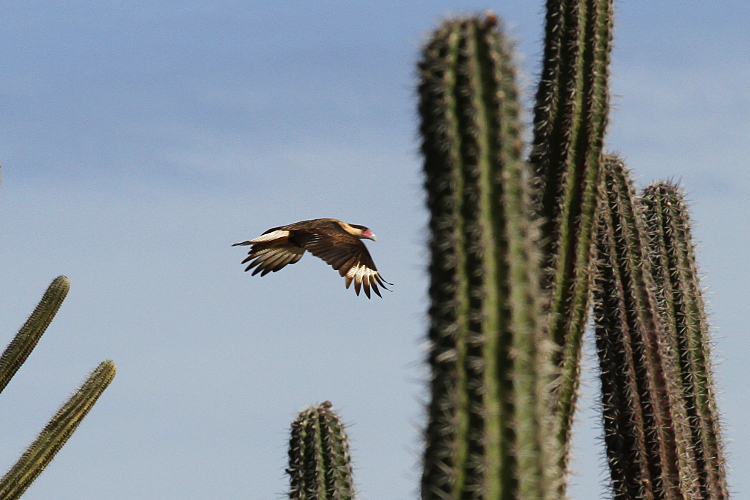
Eventually it tired of us and took off.
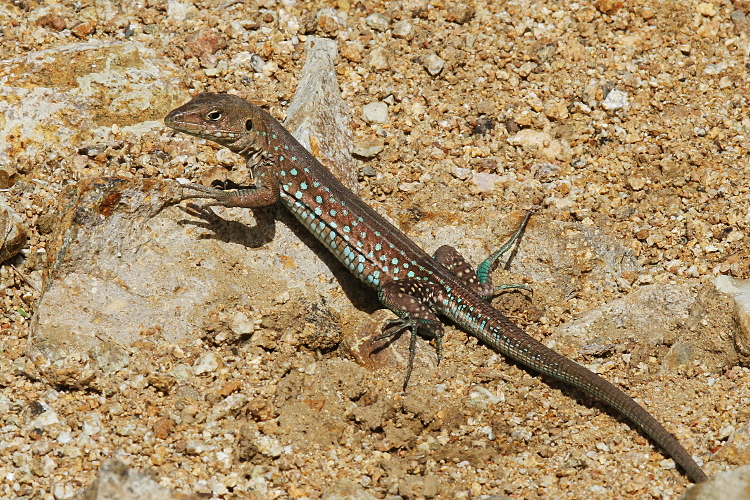
Cododo. If you look carefully at the shadow of its left front foot,
you will see that the foot is off the ground. It is actually waving
with its foot. This was very common to see. No, it's not waving hello
to me. Apparently this amusing behavior is a signal (semaphore) to other
Cododos that there is danger in the area.
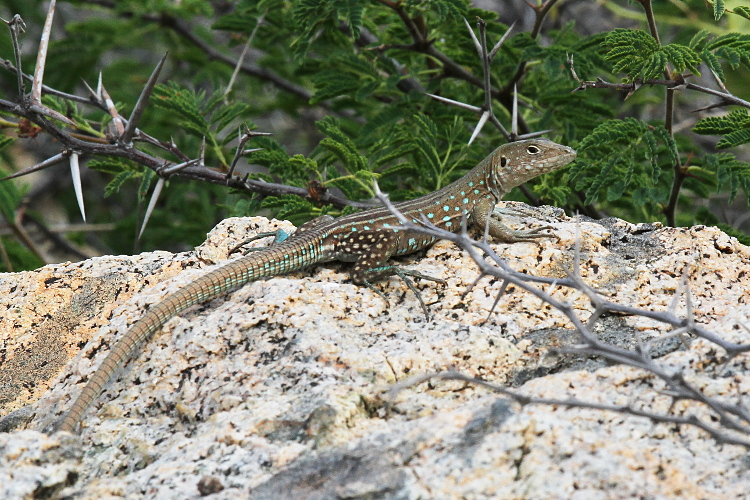
Another Cododo.
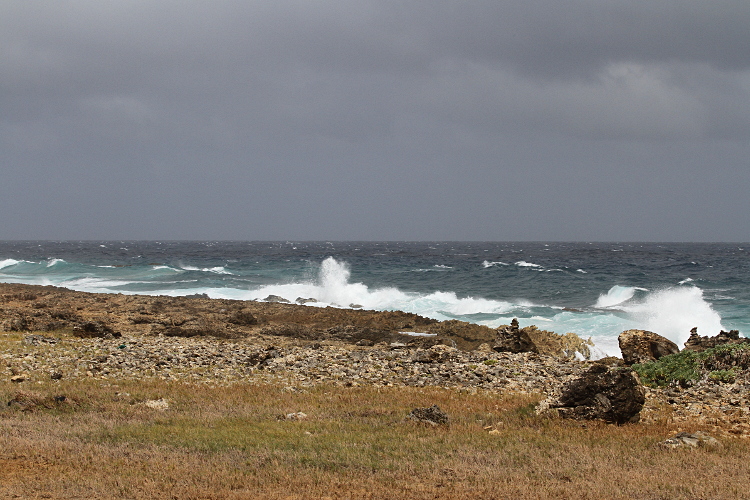
The shoreline near where we stayed. We got rained on a couple of
minutes after this photo was taken.
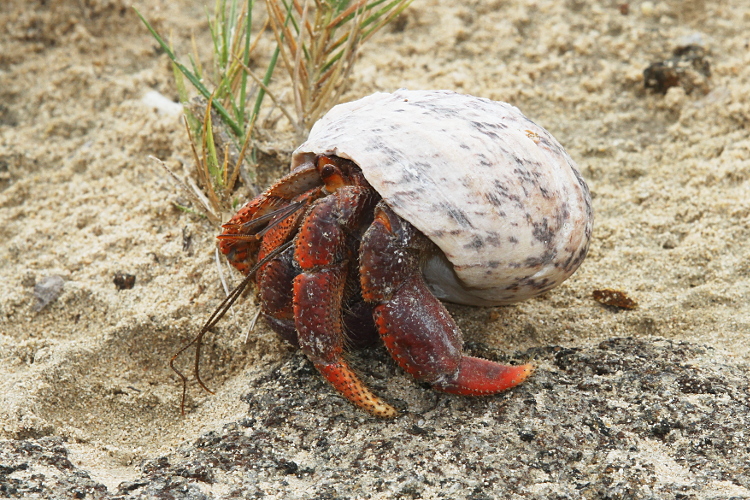
A Hermit Crab found near the beach. They seemed to live all over the island.
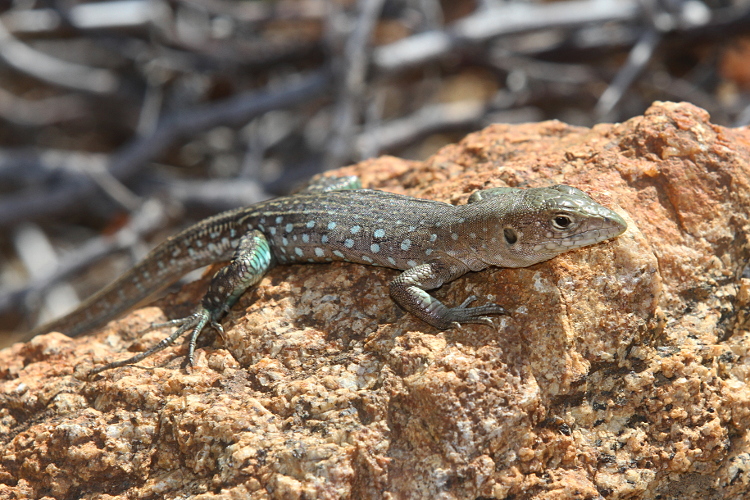
Cododo.

A large male Cododo.
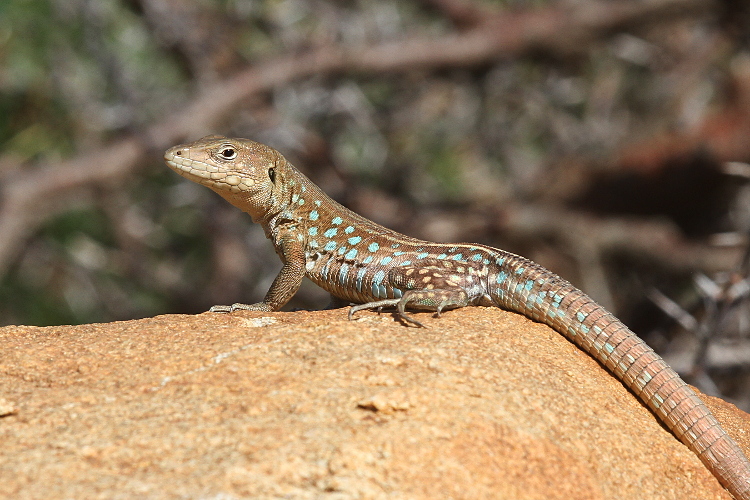
I think this one may be a female.
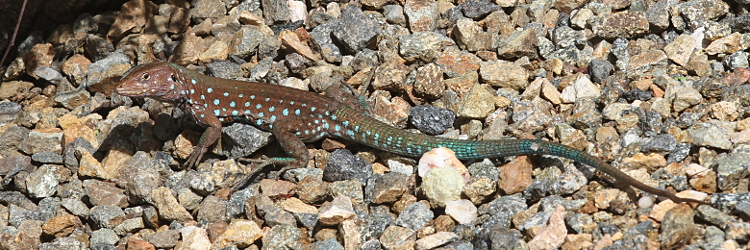
A Cododo in some landscaped gardens where we stayed.
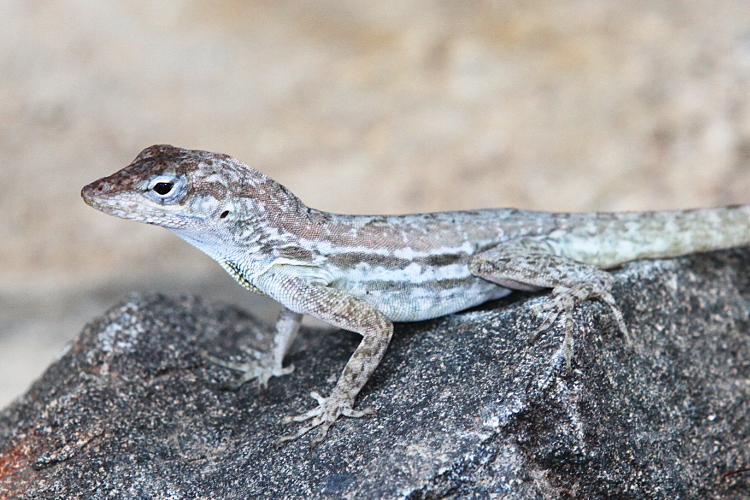
A Striped Anole (Anolis lineatus). We saw this one several
times on the rocks right outside our front door. It was the only one we saw.
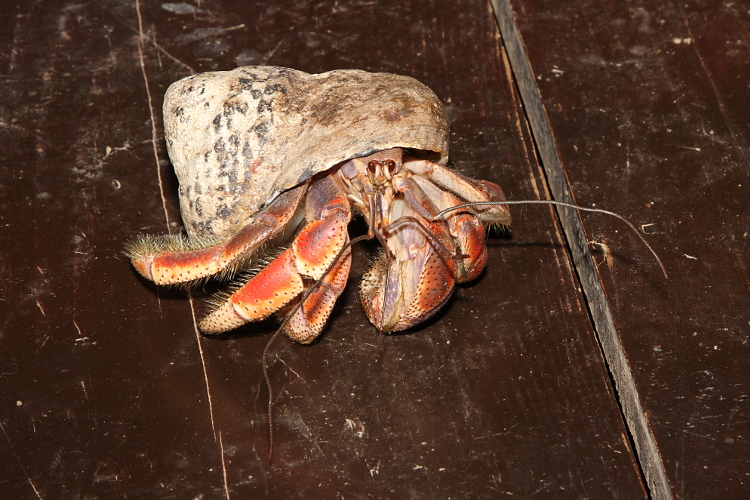
A Hermit Crab that we found on our deck one evening.
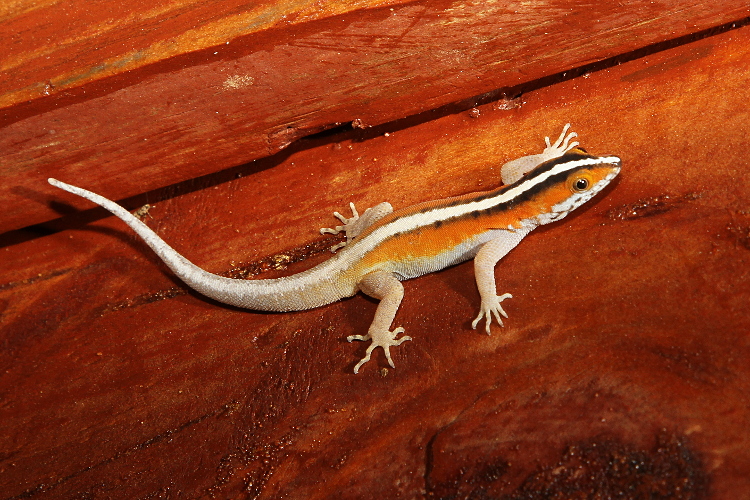
A beautiful male Wiegmann's Striped Gecko (Gonatodes vittatus)
observed on the side of our house.
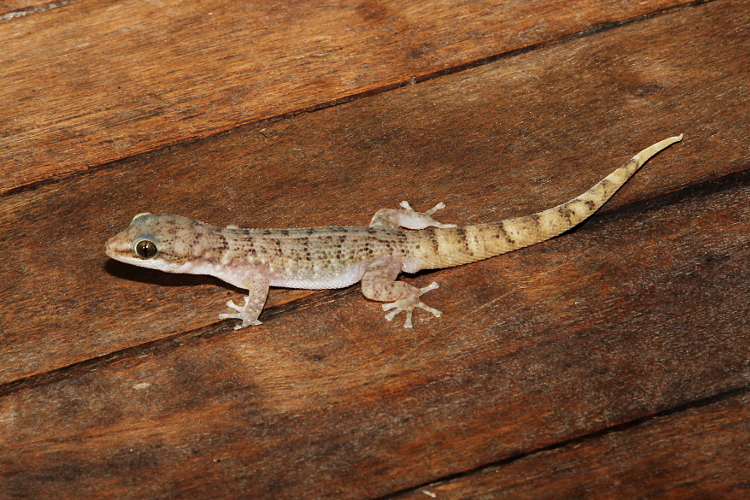
Aruba Leaf-toed Gecko (Phyllodactylus julieni).
The were common to see around our rental after dark.
This one was on a table on the deck.
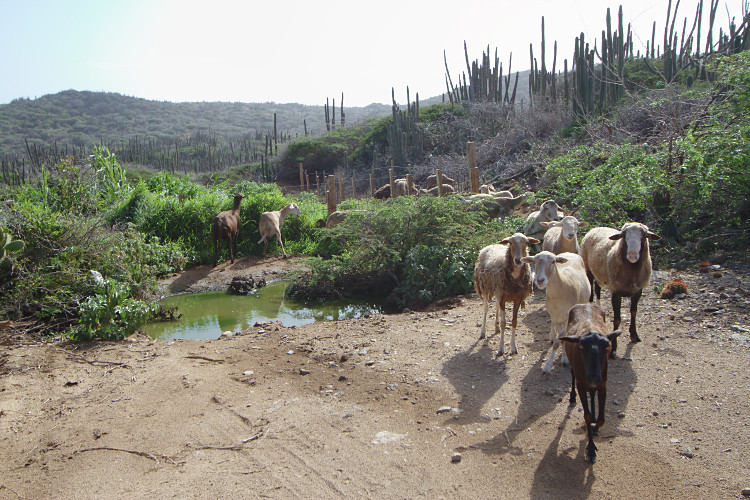
The walk to the beach took us past a small farm. These sheep were amusing.
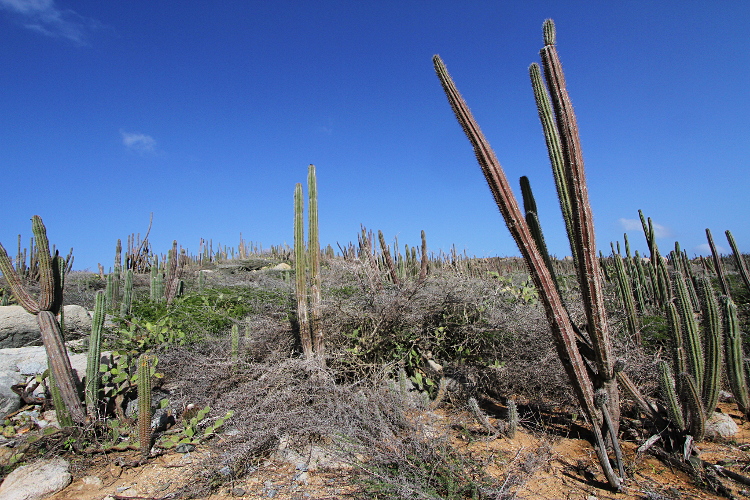
View along the walk to the beach.
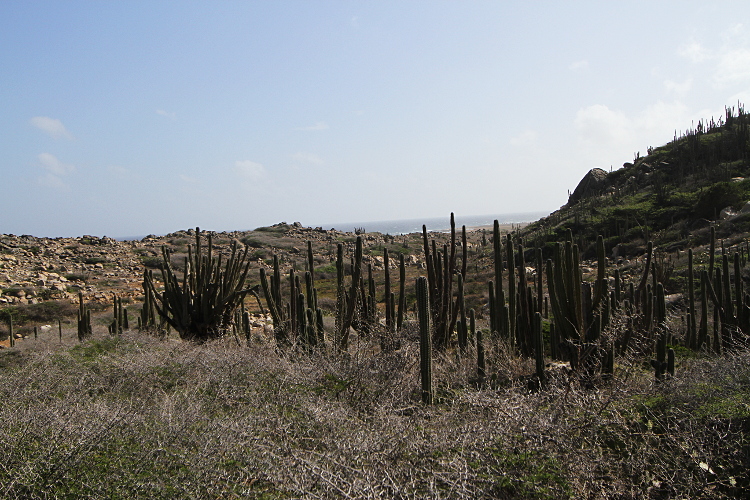
More scenery.
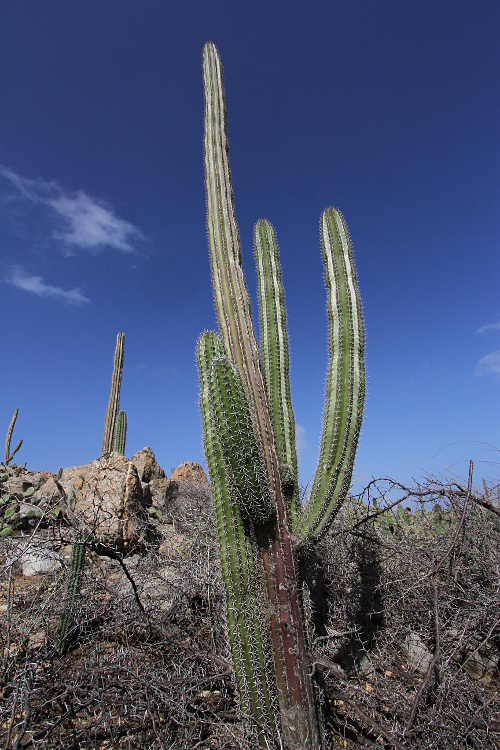
Tall cactus.
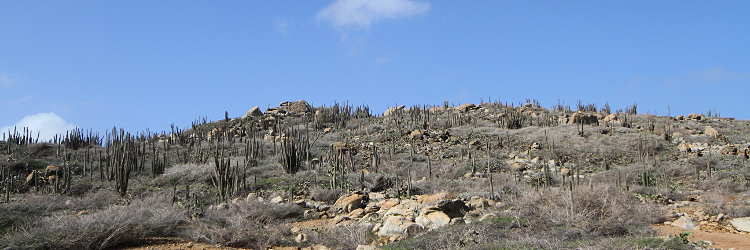
Rocky hillside.
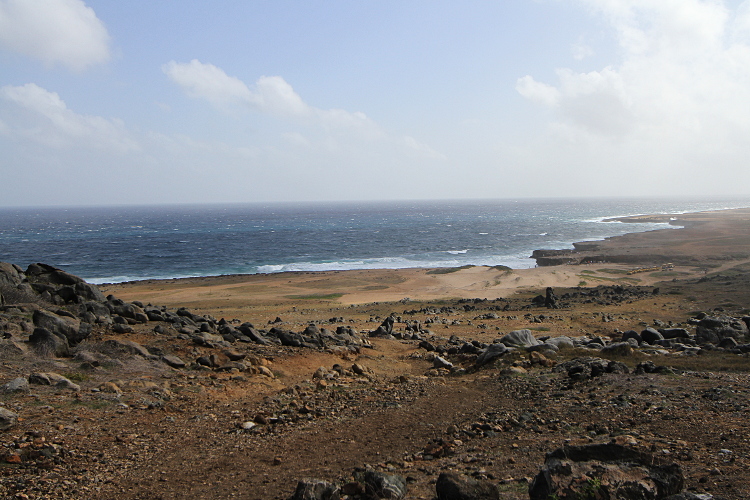
Looking out at the ocean.
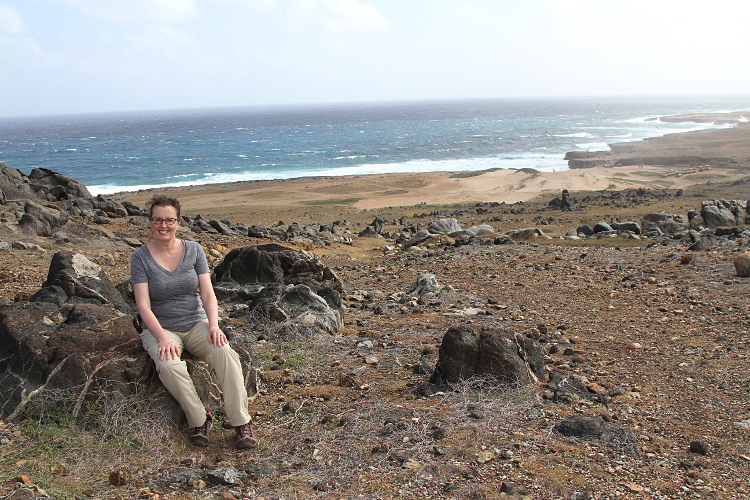
Rox and the ocean. Everywhere on Aruba was windy but this spot, where
the onshore wind whips over a ridge, seemed to be particularly gusty.
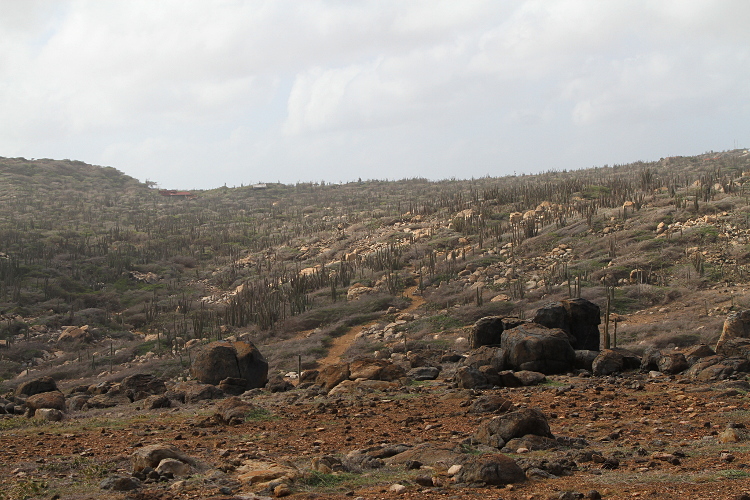
Looking towards our condo from where the previous photo was taken.
You can see the walking path near the center of the photo.
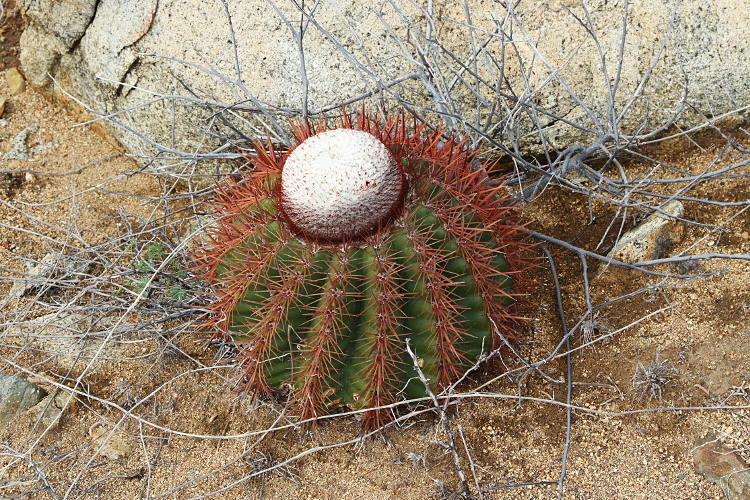
A barrel cactus of some sort.
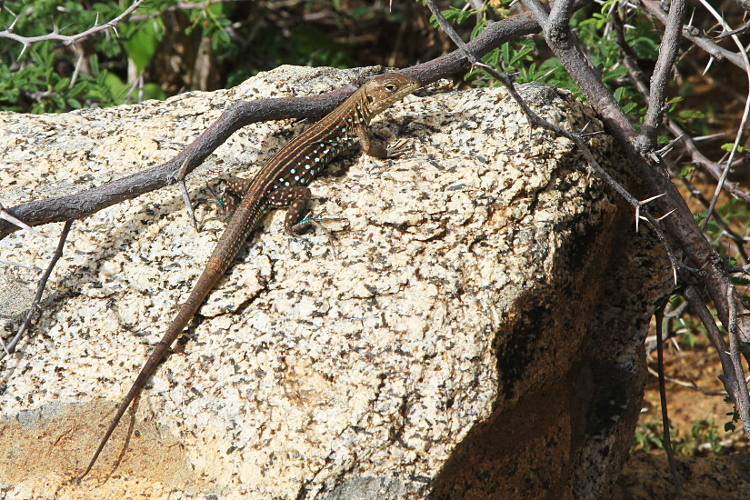
A Cododo on a chunk of granite. As a mentioned before, a lot of the rocks
reminded me of southern California.
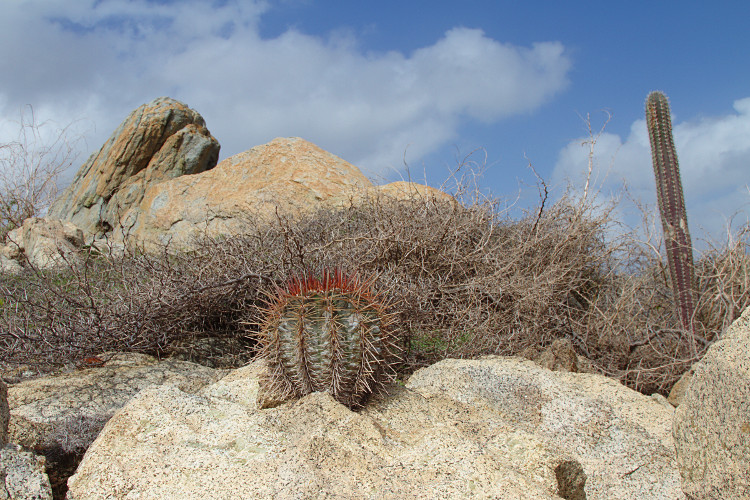
A barrel cactus growing out of a crack in a rock.
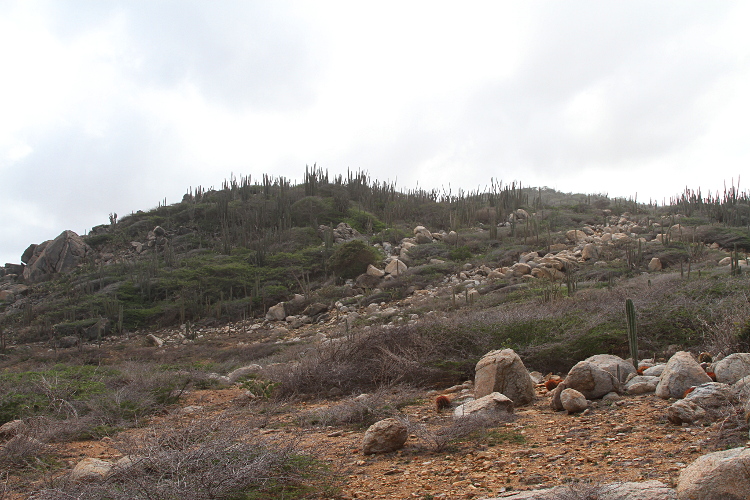
More scenery.
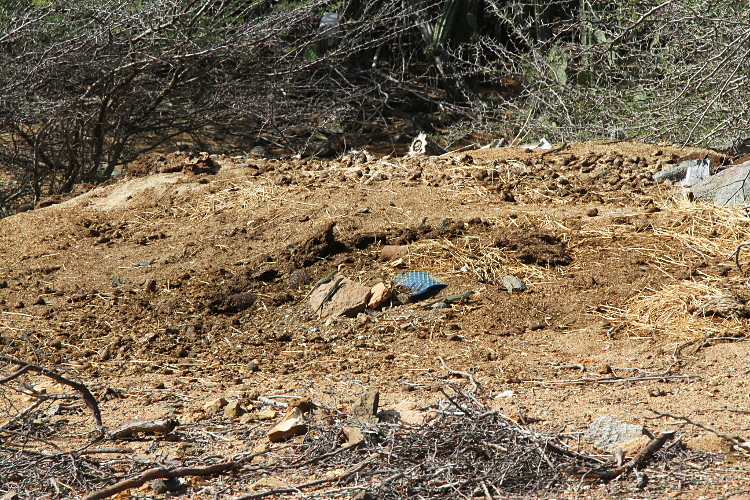
A manure pile at the small farm near our condo that attracts a remarkable
number of Cododos. You can see some lizards on the stone near the center.
A careful inspection of the full-resolution photo shows there are 9 Cododos
and 2 Cope's Ameivas in the picture.
Some more had run off before I could snap the photo.
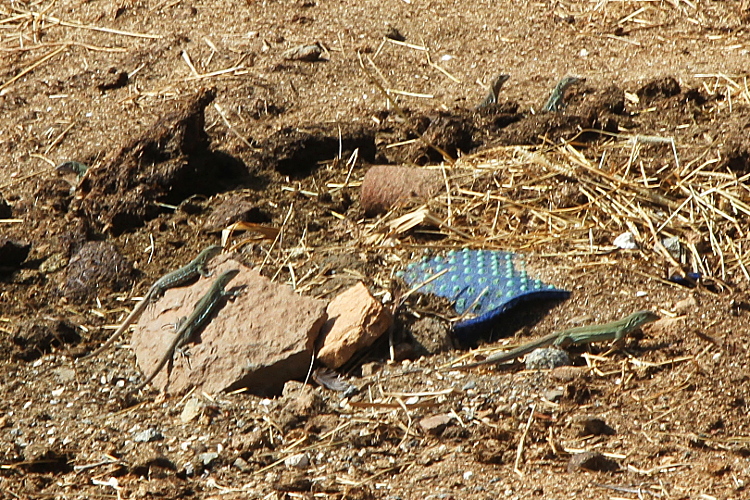
This is a full-resolution crop from the center of the previous photo.
I believe it shows 5 Cododos and 1 Cope's Ameiva.
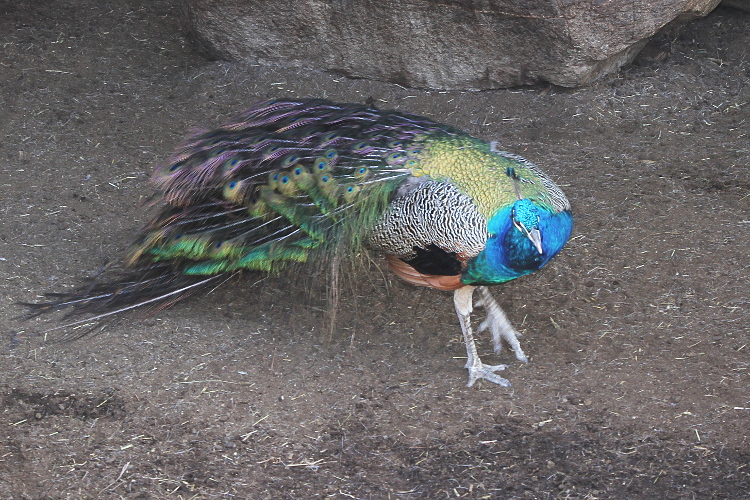
A Peacock at the farm.
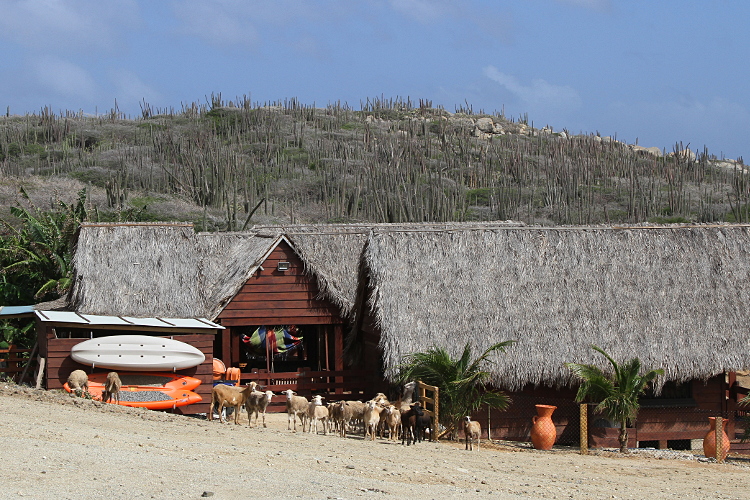
Silly sheep.
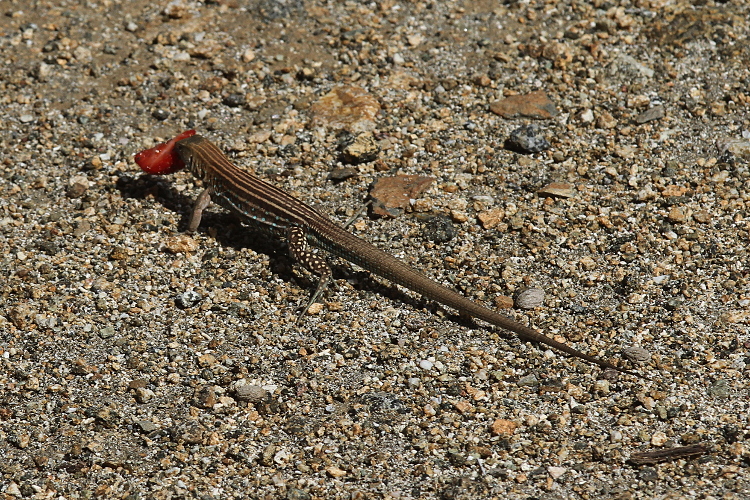
A Cododo running off with a piece of strawberry. It turns out
they naturally eat a lot of vegetable matter. We typically ate our
breakfast outside on the deck right around the time the lizards were
becoming active. We shared bits of bananas, grapes, and strawberries
with them which they all devoured eagerly.
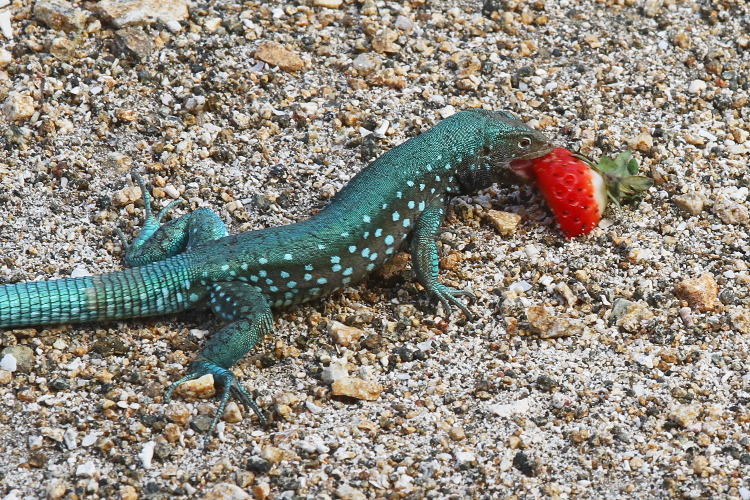
A beautiful male Cododo with a piece of strawberry.
On one day I encountered a big one, perhaps this very lizard, in our kitchen.
It hid under the fridge and eventually left on its own.
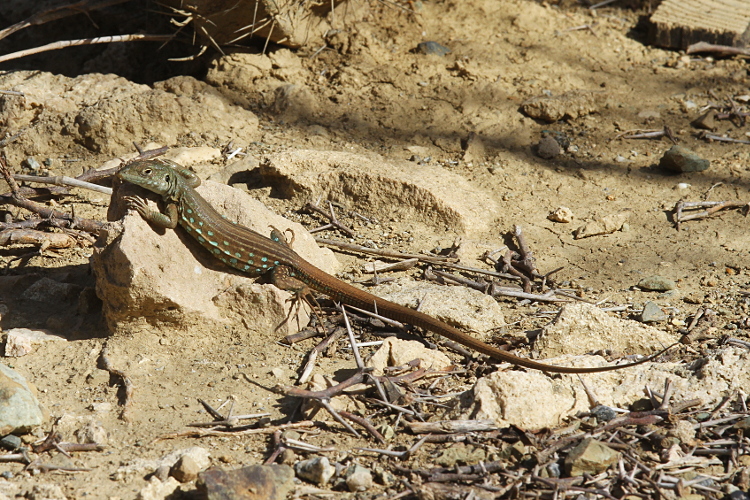
Just another Cododo...
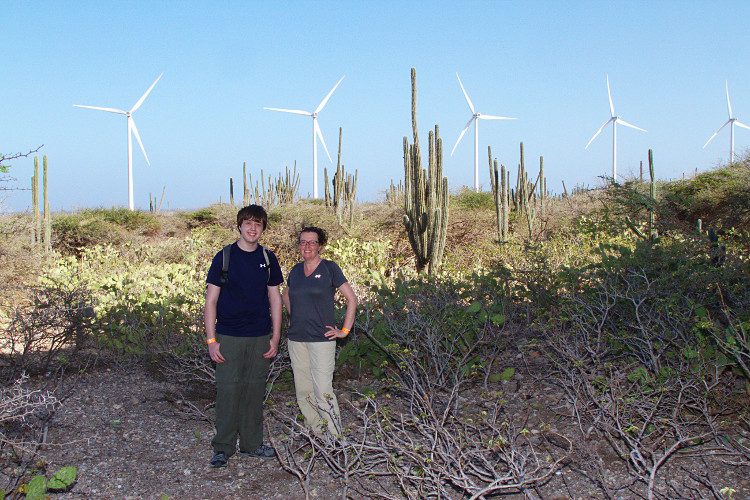
Ryan and Roxanne on the east side of Aruba.
There are a number of wind turbines for generating electricity here --
which makes total sense on an island with tons of wind.
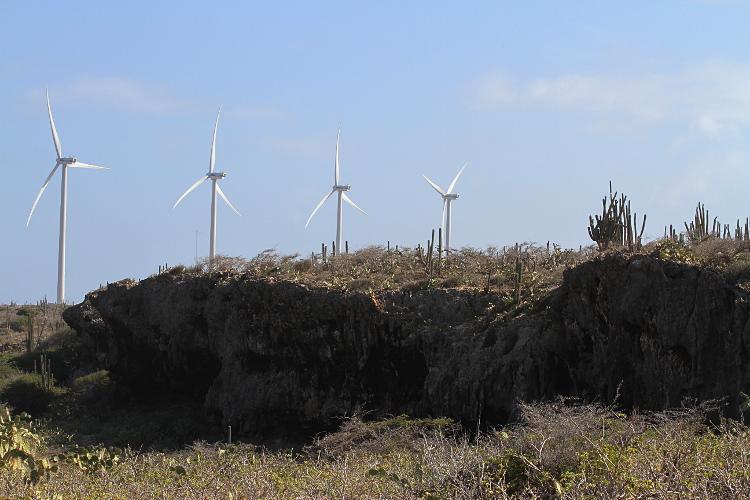
This part of the island has coral limestone cliffs and caves.
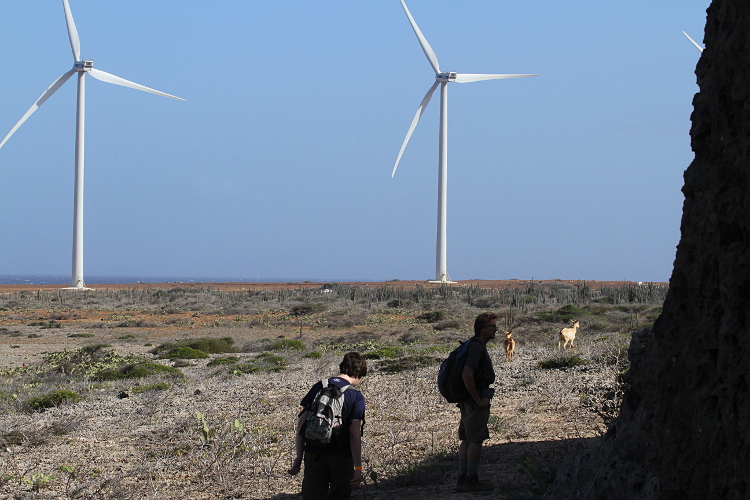
Ryan and I and some goats. There are a large number of wild goats on
the island.
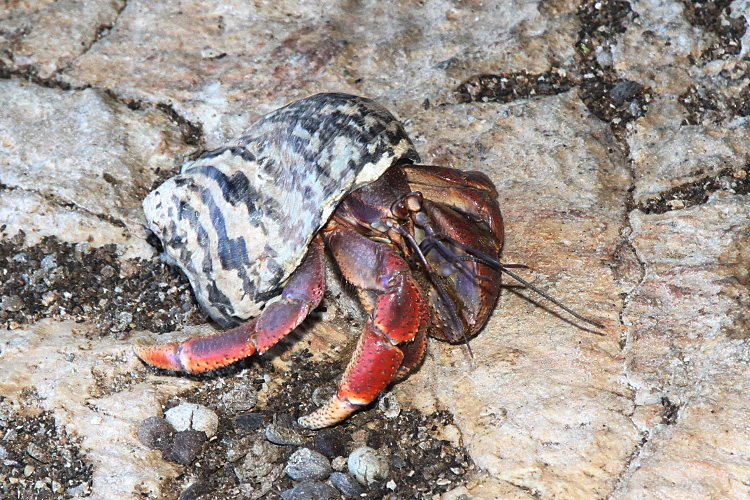
A Hermit Crab.
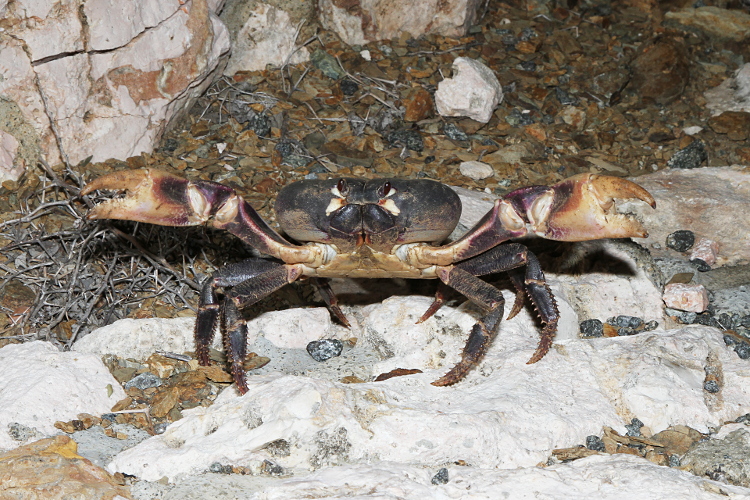
A large land crab see after dark. These were remarkably abundant
in some areas.
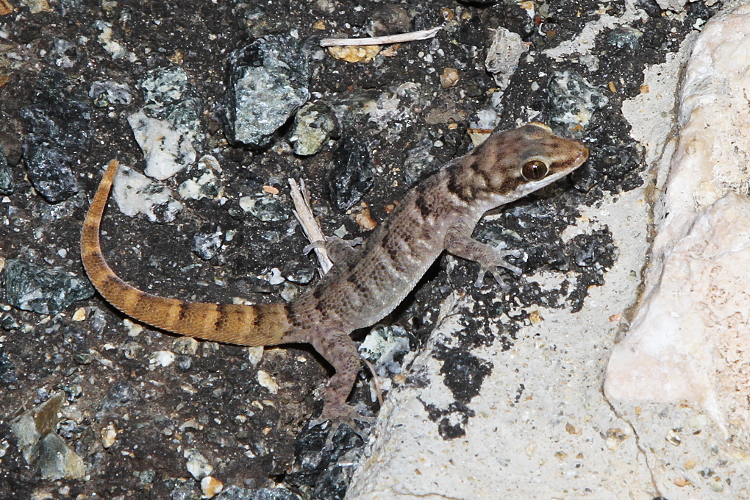
Aruba Leaf-toed Gecko (Phyllodactylus julieni).
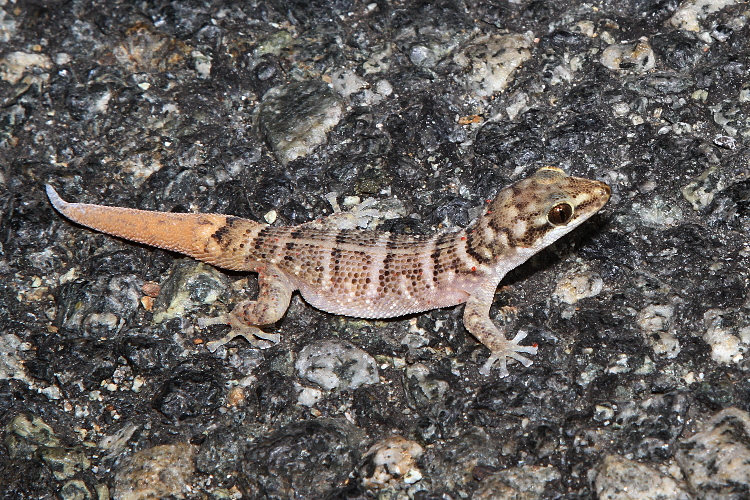
Another Aruba Leaf-toed Gecko.
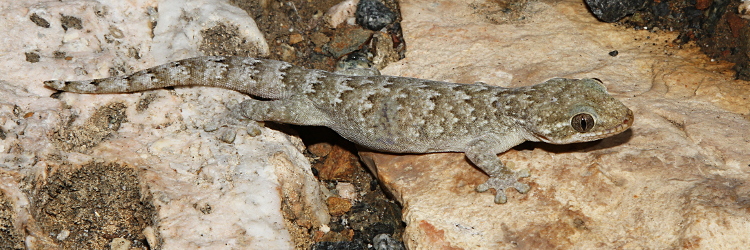
Turniptail Gecko (Thecadactylus rapicauda). None of the ones
we saw had the fat tail (aka turnip tail) like the one we saw in Belize
several years ago.
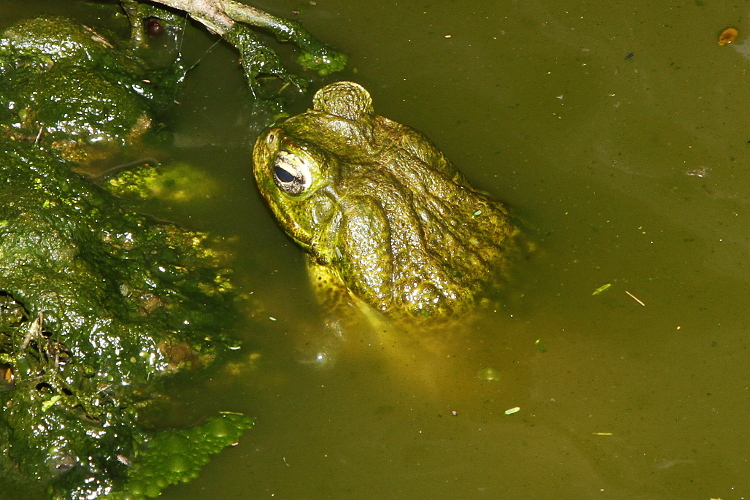
Marine Toad (Rhinella marinus). A large toad also known as
the Cane Toad was introduced to Aruba in the 1960s. It has been introduced
in many places around the world where there is a reasonably warm climate,
including islands. (e.g., Florida, Hawaii, and the Philippines).
This one was in the watering hole at the farm near where we stayed.
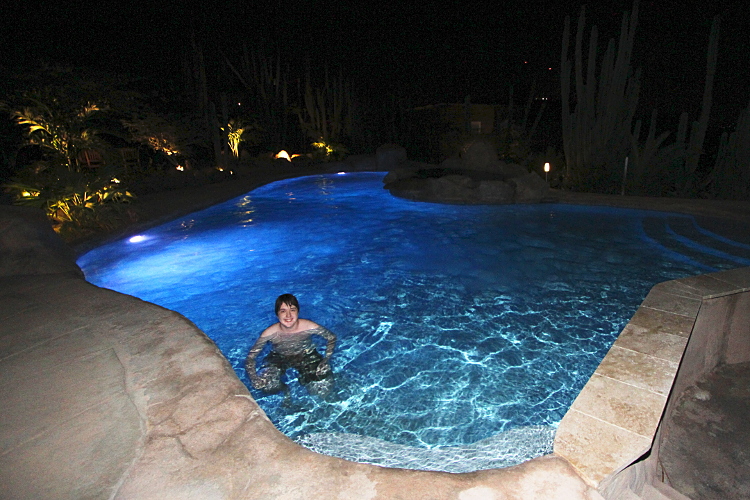
Ryan chilling in the pool.
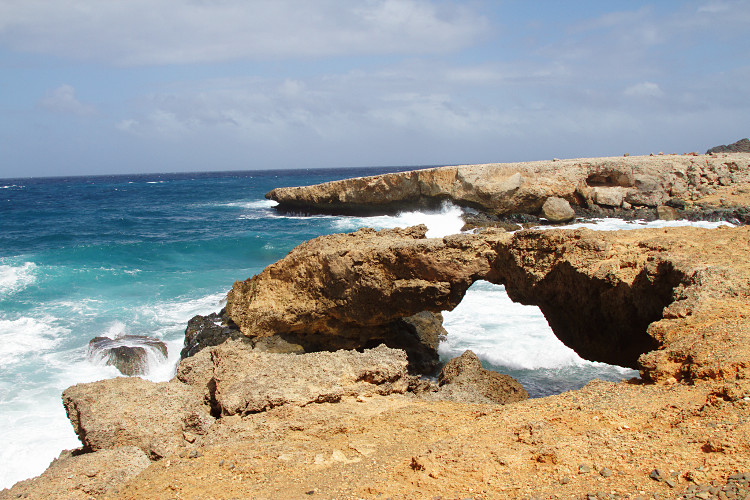
A natural bridge.
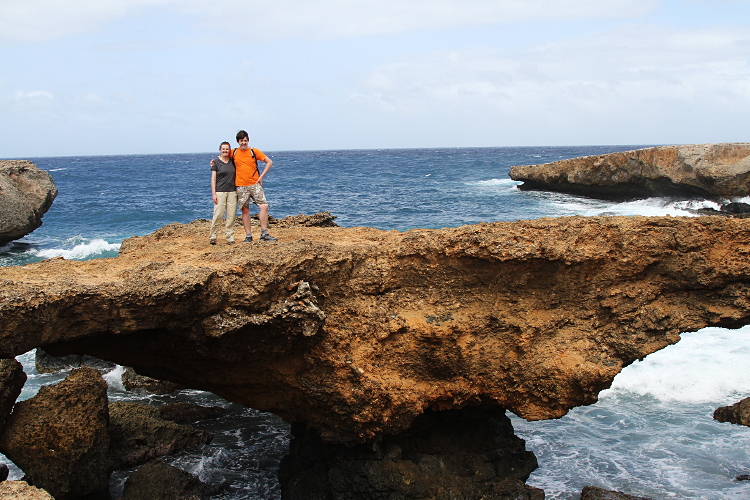
Rox and Ryan on the bridge.
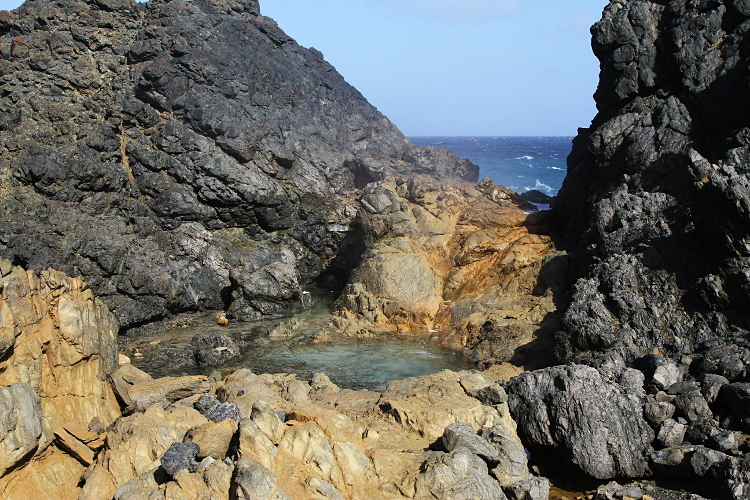
A natural pool. It gets refilled every time a big set of waves comes
in and then slowly empties.
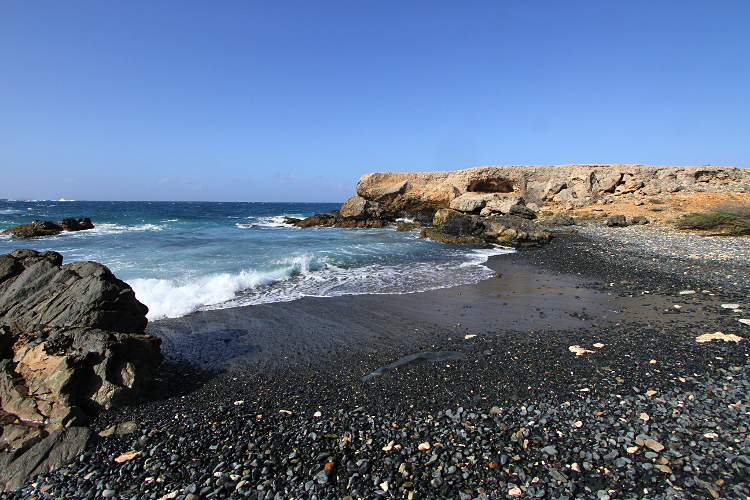
A nice little cove with black sand and stones.
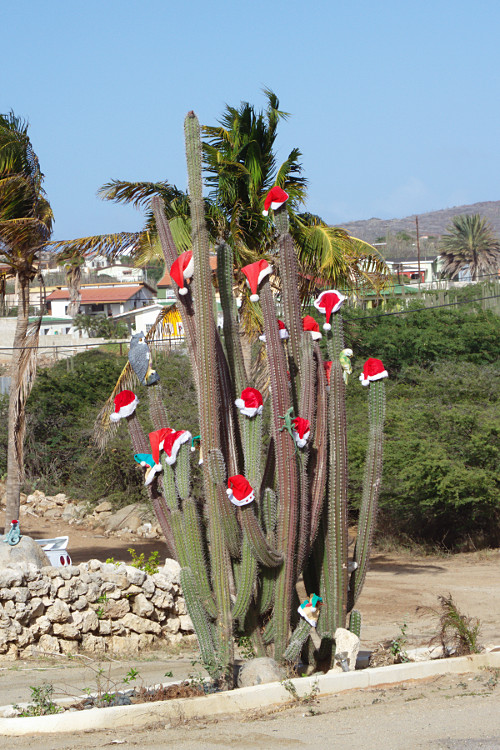
This is how you decorate your yard for Christmas in Aruba.
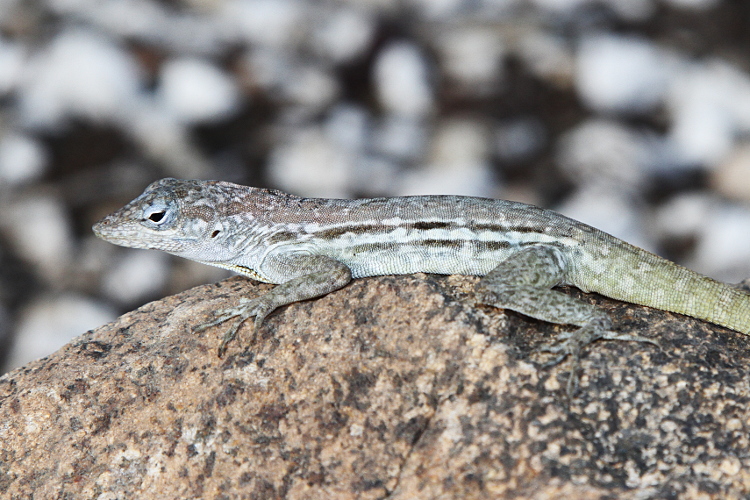
Another look at our resident Striped Anole, a few days later.
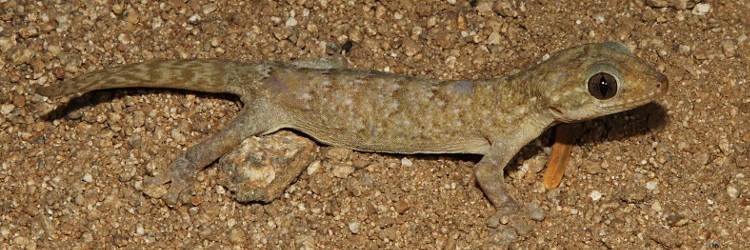
Turniptail Gecko (Thecadactylus rapicauda).
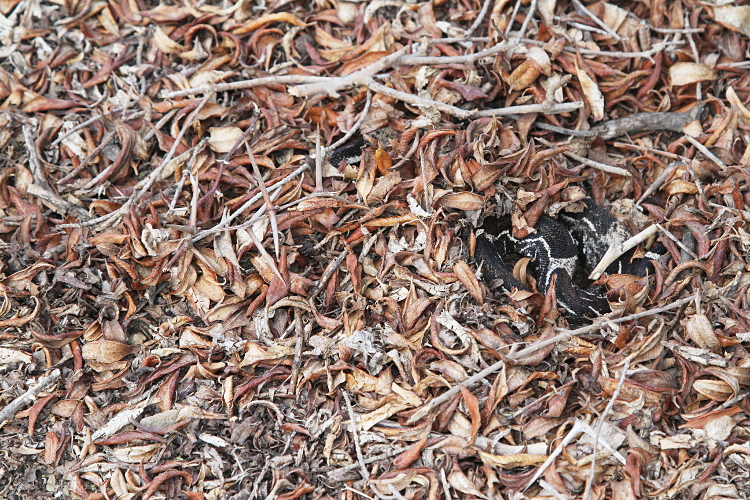
Roxanne and I went for a hike one morning. I found this patch of leaf
litter to be suspicious...
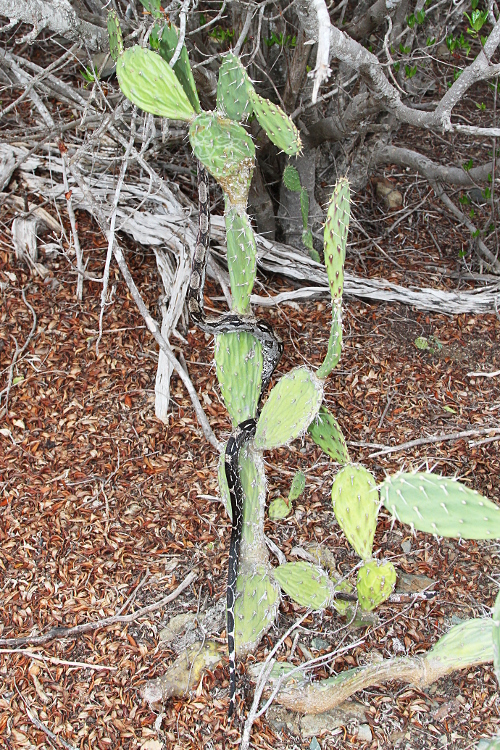
After I lifted it up out of the leaves with a stick, the
Boa Constrictor (Boa constrictor) climbed up a cactus and
this into a small tree.
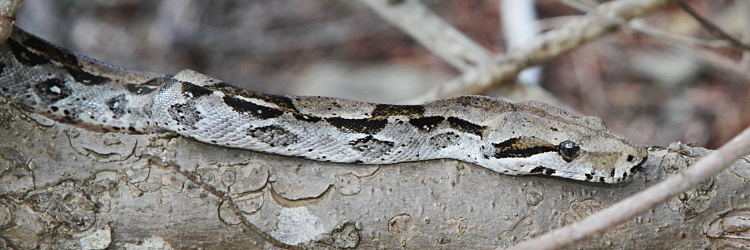
Another look at the boa.
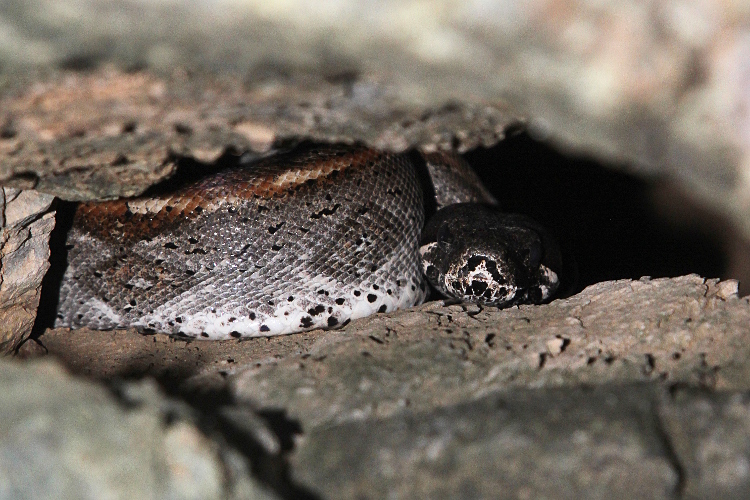
A different Boa Constrictor that Roxanne spotted under a rock.
Boa Constrictors were first documented on Aruba in 1999. According to
Genetic Characterization of an Invasive Boa constrictor Population on the
Caribbean Island of Aruba, L.M. Bushar et al.,
Journal of Herpetology 49(4), 602-610 (2015): "We conclude that the
present B. constrictor population on Aruba most likely resulted from
the release or escape of a small number of unrelated captive snakes originating
from South America (B. c. constrictor) and are phylogenetically
distinct from introduced boas on Puerto Rico and Cozumel."
There are concerns that Boa Constrictors will have a negative impact on
the native wildlife in Aruba. They certainly are quite common on the
island. In addition to the two shown above, we saw three that had been
run over by automobiles and one was that killed by the farmers near our condo.
We found the dead snake right next to the chicken coop -- it is easy to
understand why the snake was there and also why the farmers wanted it dead...
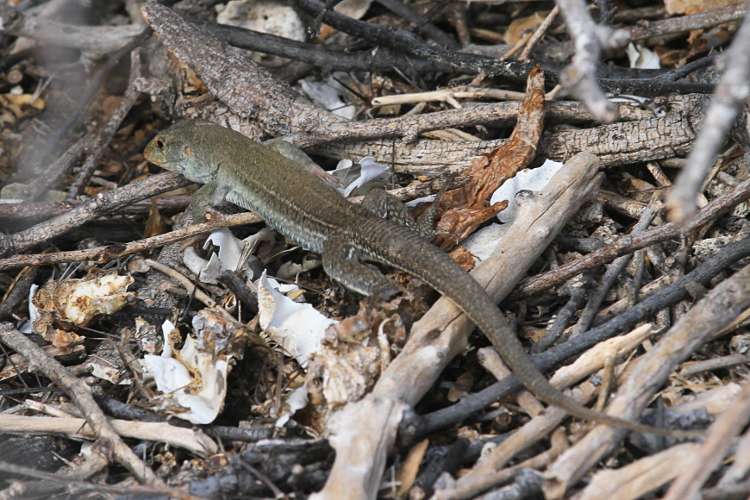
Cope's Ameiva (Ameiva bifrontata).
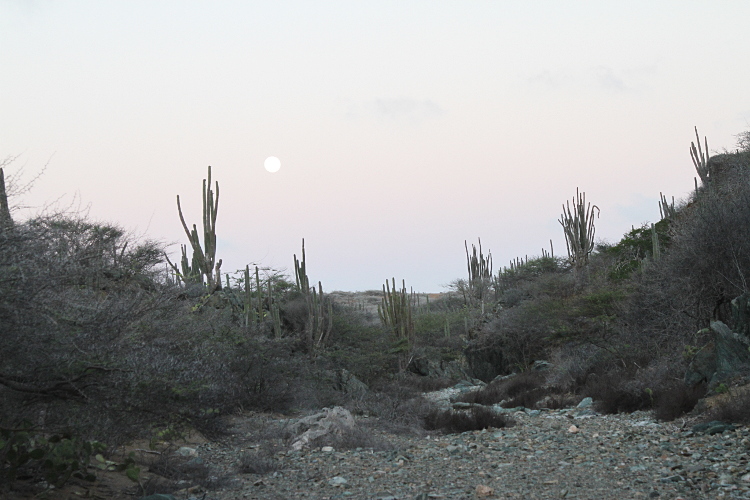
The full moon at sunset.
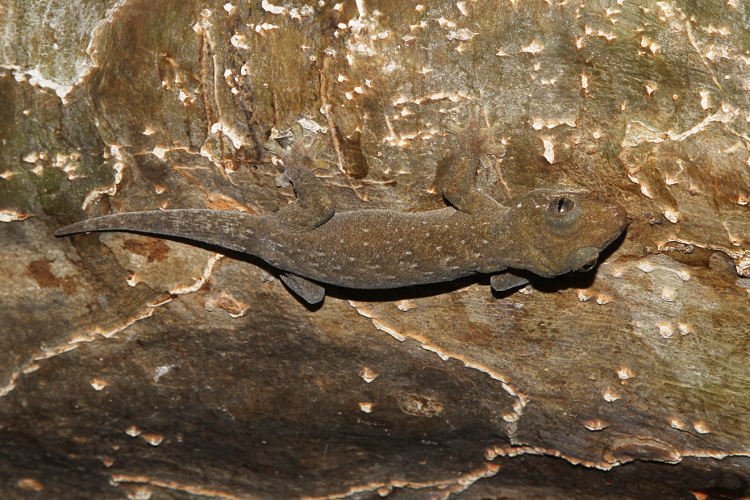
A Turniptail Gecko (Thecadactylus rapicauda) found on a large
fallen tree at dusk. This was near where the previous photo was taken.
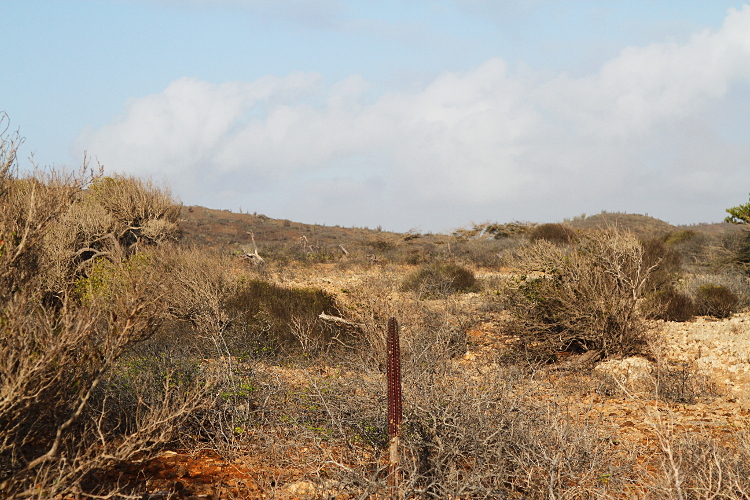
Coral limestone (barranca) landscape.
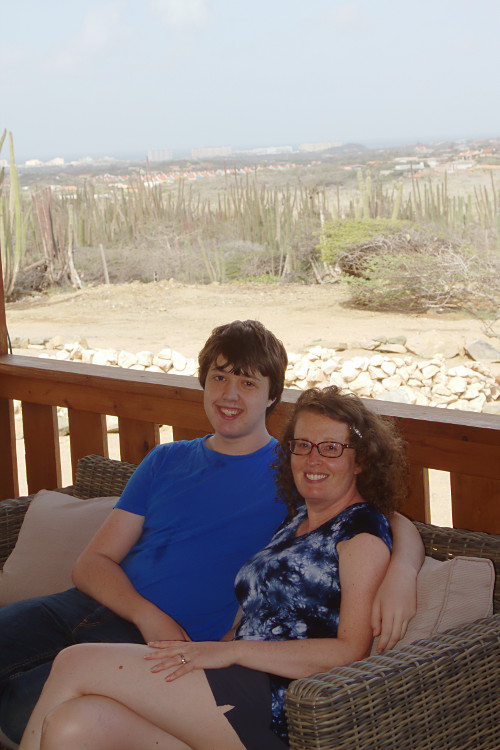
Ryan and Roxanne on our deck. The more developed part of Aruba, with large
hotels and shopping, is in the distance. We did spend some time in that
area dining, etc..., but I did not take any photos of it.
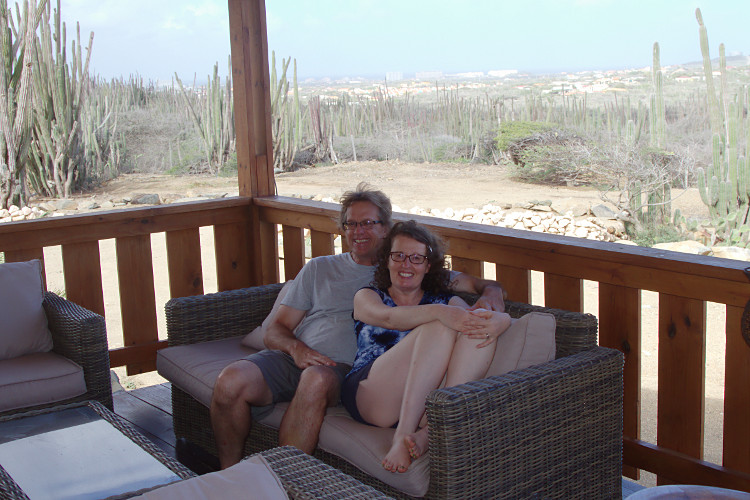
Carl and Roxanne.
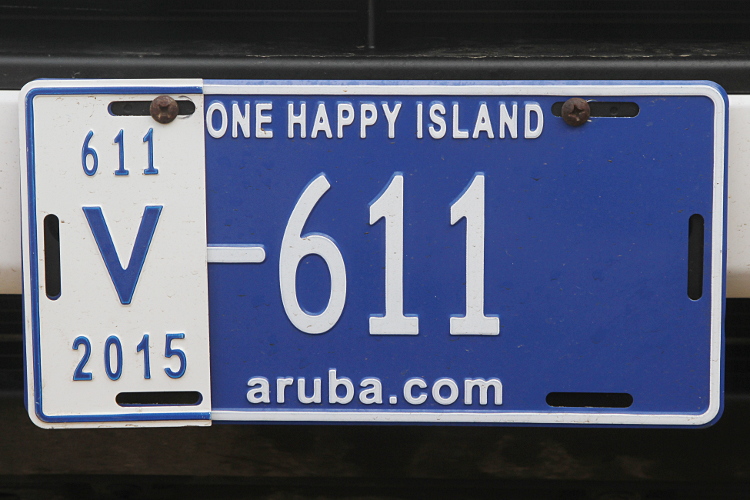
The license plates in Aruba were amusing. Driving was not bad. One thing
that took some getting used to is that the only street signs are at the
intersections of major roads. So most of the time you just wing it -- since
it is a pretty small island you really can't get too far off track.
It was a fun trip and also very nice to have all three of us together
again, since Ryan started college this fall at Ohio State.


































































